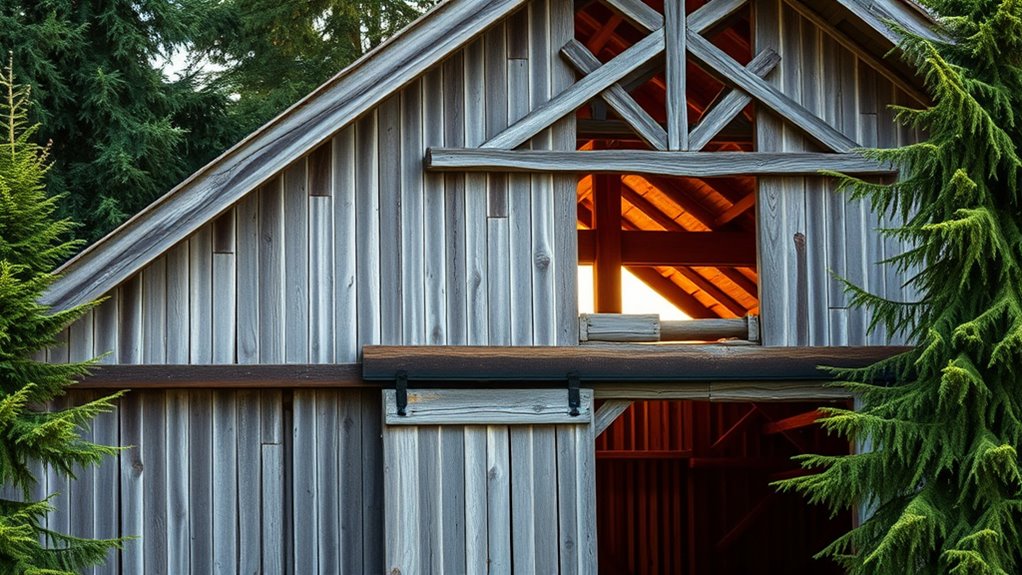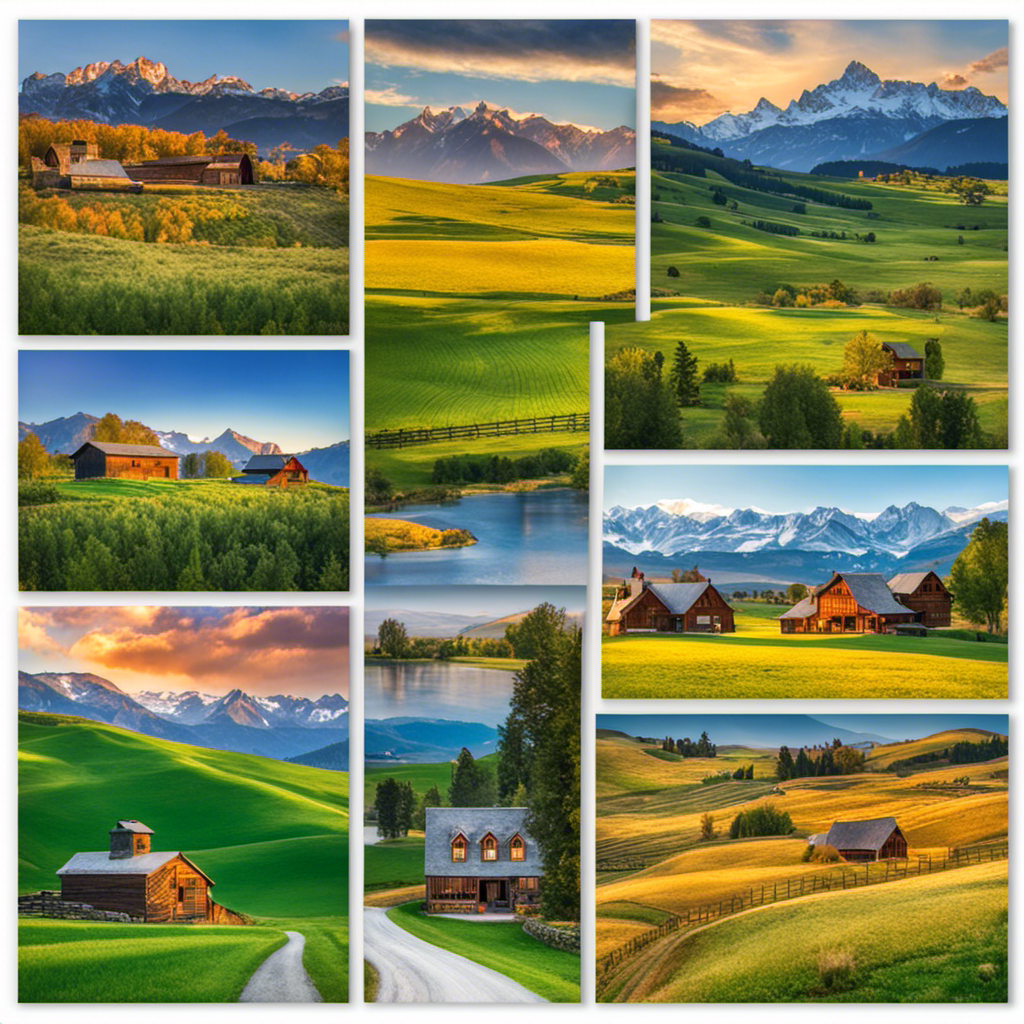In the Pacific Northwest, barn styles often reflect practicality and regional traditions, showcasing local timber like Douglas fir and cedar. You’ll notice steep gable roofs and gambrel designs that suit the climate and farming needs. Timber framing is a key feature, with exposed beams and intricate joinery highlighting craftsmanship rooted in regional history. These structures symbolize resilience and resourcefulness, revealing a deep connection to the area’s lush forests. Exploring further uncovers the rich timber lore shaping these enduring buildings.
Key Takeaways
- Regional barn styles like gable and gambrel roofs reflect practical adaptations to local climate and terrain.
- Timber framing techniques, including mortise and tenon joints, showcase regional craftsmanship and resourcefulness.
- Use of local timber species such as Douglas fir and cedar emphasizes durability and regional resourcefulness.
- Exposed beams and intricate joinery serve both structural and aesthetic purposes, highlighting timber lore.
- Barn architecture embodies regional identity, resilience, and the cultural significance of timber craftsmanship in the Pacific Northwest.

Nestled amidst the lush forests and rugged landscapes of the Pacific Northwest, barn styles and timber craftsmanship reflect a rich blend of practicality and tradition. As you explore the region’s barns, you’ll quickly notice how timber framing plays a vital role in their construction. Timber framing is more than just a building technique; it’s an art form that has been passed down through generations. The sturdy, exposed beams are not only functional but also serve as a visual proof of craftsmanship and durability. You can see how the carefully joined timbers form intricate patterns—mortise and tenon joints, pegged connections—that speak to the skill of the builders. This traditional barn architecture ensures the structures withstand the region’s heavy rains and seismic activity, making them as resilient as they are iconic.
When you look at the various barn styles in the Pacific Northwest, you’ll notice a distinct influence of timber framing that shapes their character. The classic gable barn with its steeply pitched roof is common, designed to shed snow and rain efficiently. You might also encounter the gambrel roof style, which maximizes interior space for hay storage and livestock. These designs are adaptations to the local climate and agricultural needs, but what unites them is the visible timber framework that supports the entire structure. The use of local timber species, like Douglas fir and cedar, is deliberate—these woods are abundant, strong, and naturally resistant to decay. The choice of timber and the techniques used reflect a deep respect for the land and a need for longevity.
You’ll find that barn architecture in the Pacific Northwest often emphasizes function, but it also reveals a respect for tradition. The timber framing isn’t just about structural integrity; it’s about showcasing craftsmanship. Many barns feature exposed beams and trusses that highlight the artistry involved in their construction. These elements aren’t merely structural—they serve as visual anchors that connect the building to regional heritage. As you walk through these barns or see them from afar, you’ll appreciate how their form and function are intertwined, rooted in a practical understanding of local resources and environmental challenges. The region’s rich timber lore is embedded into every beam and joint, telling stories of generations who relied on these structures for survival and prosperity.
Frequently Asked Questions
How Have Pacific Northwest Barn Designs Evolved Over Centuries?
You’ve seen how barn designs have evolved through a barn revival, blending traditional and modern styles. Over centuries, these structures shifted from purely functional to symbols of community and resilience, showcasing architectural symbolism. Today, you notice a mix of rustic charm and innovative touches, reflecting changing needs and aesthetics. This evolution highlights how barn styles adapt while honoring their historical roots, making them timeless yet contemporary symbols of regional identity.
What Are the Primary Types of Timber Used in Regional Barns?
You’ll find that cedar, Douglas fir, and hemlock are the primary types of timber used in regional barns. These choices are based on timber selection, favoring woods that are naturally resistant to decay and pests. To guarantee durability, builders focus on effective wood preservation techniques, treating the timber to withstand the damp climate and extend the barn’s lifespan. This careful selection and preservation keep regional barns strong through the years.
Are There Specific Local Traditions Influencing Barn Architecture?
You’ll notice that indigenous influences and regional craftsmanship heavily shape barn architecture here. Local traditions emphasize functional design, using locally sourced timber and sustainable techniques. These influences lead to unique features like intricate woodwork and adaptive structures suited to the climate. By embracing indigenous aesthetics and craftsmanship, regional barns reflect a deep respect for heritage while ensuring practicality and durability in construction.
How Do Climate Conditions Impact Barn Construction Choices?
You need to adapt your barn construction to the climate, as it’s the best way to weather the storm. Climate conditions influence your choice of construction materials—using wood and metal for durability and insulation against rain, snow, and humidity. Proper climate adaptation guarantees your barn withstands harsh weather, reducing maintenance and extending its lifespan. Remember, a well-built barn is only as good as how it’s tailored to its environment.
What Conservation Efforts Exist for Historic Pacific Northwest Barns?
You can participate in conservation efforts by supporting restoration techniques that preserve historic barns, ensuring their structural integrity and cultural significance. Community preservation initiatives often involve local volunteers and organizations working together to restore and maintain these structures. By engaging in or donating to such efforts, you help protect the region’s heritage, allowing future generations to appreciate the craftsmanship and history embedded in these historic Pacific Northwest barns.
Conclusion
As you walk through the rugged charm of Pacific Northwest barns, you’re touching centuries of timber whispering stories of strength and tradition. These structures are more than just buildings—they’re living tapestries woven from history and heartwood. Each style and timber choice paints a vivid picture of resilience in the face of nature’s wild dance. So, next time you see one, remember, you’re gazing at a majestic sentinel, standing proud like a guardian of time’s silent secrets.










